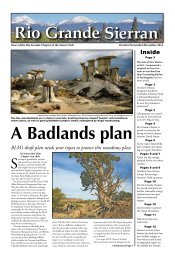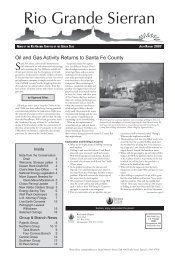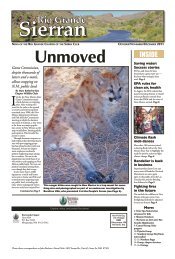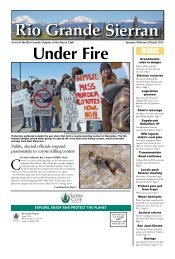Choosing pollution Your photo - Rio Grande Chapter
Choosing pollution Your photo - Rio Grande Chapter
Choosing pollution Your photo - Rio Grande Chapter
You also want an ePaper? Increase the reach of your titles
YUMPU automatically turns print PDFs into web optimized ePapers that Google loves.
Wildlife<br />
N.M. Game Commission ignores public<br />
By Mary Katherine Ray<br />
<strong>Chapter</strong> Wildlife Chair<br />
An item on the New Mexico<br />
Game Commission’s<br />
June 9 meeting agenda said<br />
the Department of Game<br />
and Fish was seeking “guidance” on the<br />
wolf-reintroduction program.<br />
Not knowing what form that might<br />
take, wolf supporters gathered before<br />
the Game Commission meeting, waved<br />
signs and cheered for wolves as Game<br />
Commissioners drove in. Speakers at<br />
the rally included a wolf-country campground<br />
owner and a mom who lives on<br />
the Gila Forest boundary who wants<br />
wildlife diversity including wolves in<br />
the world for her kids. A mammologist<br />
spoke about the ecological importance<br />
of wolves and even a hunter spoke<br />
about supporting wolf recovery.<br />
When the wolf agenda item was up<br />
that afternoon, the Department presented<br />
the costs of the program since<br />
1999. In more than 11 years, the Department<br />
of Game and Fish has spent<br />
only about a half-million dollars, and<br />
the federal government $1.4 million.<br />
The Department share amounts to<br />
$42,000 a year, a paltry sum considering<br />
its annual budget of nearly<br />
$40 million. But it was clear this was<br />
shaping up to be a question about<br />
money, or more importantly, about<br />
whether the Department should spend<br />
even a dime on any creature that can’t<br />
be shot by hunters.<br />
During the meeting, 16 people stood<br />
up and spoke in support of wolves,<br />
citing their importance as keystone<br />
carnivores to maintain ecosystem<br />
health, their ability to keep herds<br />
healthy, the desire to be able to see and<br />
hear wolves in their native habitat, and<br />
about working to find creative solutions<br />
to conflicts with ranchers. Commissioners<br />
were reminded that a 2008<br />
poll showed that 69 percent of voters<br />
supported wolf reintroduction.<br />
The anti-wolf factions were represented<br />
by the usual fear-mongering:<br />
Wolves will eat or are eating all the elk,<br />
and ranchers are going out of business.<br />
(Remember, the population in the<br />
entire region hovers around 50 wolves.)<br />
Not only will wolves eat the children,<br />
the children have been traumatized by<br />
Photo by Mary Katherine Ray<br />
Nearly 100 wolf supporters gathered before work and the Game Commission meeting on<br />
June 9 at the New Mexico Farm and Ranch Heritage Museum in Las Cruces. Later that day,<br />
Game commissioners voted to withdraw from the wolf-reintroduction program.<br />
Wildlife and wildfires<br />
As I write, the Wallow fire has just burned its way across the forest of Eastern<br />
Arizona and into the Gila of Western New Mexico. Given how big the<br />
fire is and how much smoke is being spread all over the country, one might<br />
expect the news for wildlife would be bleak. But according to an Arizona<br />
Game and Fish official, wildlife know what to do in a fire, and usually larger<br />
animals just move and birds fly away.<br />
Small mammals can burrow underground and even just a few inches below<br />
the surface offers sufficient safety while the fire burns across the land overhead.<br />
While it appears as if the fire is completely catastrophic, it is actually burning in<br />
a mosaic pattern, devastating some areas while sparing others entirely. There are<br />
areas within the burn where wildlife can seek refuge at least for a time.<br />
The territories of three wolf packs have been in the path of the fire, but<br />
all the wolves are accounted for, and the dens with this year’s pups appear to<br />
have been spared. Still, the ability of these packs to survive in the vastly altered<br />
landscape is uncertain. An event like this fire does serve to remind us how<br />
fragile the small wolf population is. With so few individuals, it wouldn’t take<br />
much to devastate them. Never was it more clear that there need to be more<br />
wolves out there so that if some are lost there is redundancy for backup.<br />
the presences of wolves. (For the record,<br />
the number of children or adults eaten<br />
by Mexican wolves in the entire known<br />
history of the species stands at zero.)<br />
What happened next was swift but<br />
sure. Commissioner Salopek of Las<br />
Cruces made a motion to withdraw<br />
from the Mexican Wolf Reintroduction<br />
— Mary Katherine Ray<br />
program effective June 30, 2011. It was<br />
quickly seconded by Commissioner Bidegain,<br />
the representative from Tucumcari<br />
who is also on the Board of the<br />
New Mexico Cattlegrowers Association.<br />
The Commissioners one by one then all<br />
voted to withdraw from the program.<br />
It isn’t clear what this means for<br />
wolves. The reintroduction program<br />
is not suspended by this vote. N.M.<br />
Game and Fish simply won’t be participating<br />
in it. It won’t be helping mitigate<br />
depredations or advising and helping<br />
ranchers. It also won’t be involved in<br />
consultation about policy. The agency is<br />
required by law to continue to provide<br />
law enforcement for wolves, but it has<br />
walked away from the table where the<br />
other cooperating agencies still sit with<br />
the U.S. Fish and Wildlife Service. The<br />
other agencies still are the Arizona Department<br />
of Game and Fish, the U.S.<br />
Forest Service, USDA Wildlife Services<br />
(the predator-killing agency) and White<br />
Mountain Apache tribe.<br />
Commissioners violated their own<br />
public-notice policy, which had been<br />
discussed that very morning and for<br />
which it was settled that 21 days was<br />
sufficient time to alert the public to<br />
proposed action. The public notice of<br />
this act was less than 60 seconds. The<br />
Commission had the appearance of<br />
wanting to avoid scrutiny and just get<br />
it done. It also had the appearance of<br />
having been decided long before the<br />
meeting opened. What was sorely lacking<br />
was consideration of the public,<br />
of the environment, conservation and<br />
wildlife protection.<br />
Thousands ask commission to ban traps on public lands<br />
Mary Katherine Ray<br />
<strong>Chapter</strong> Wildlife Chair<br />
In response to a trapping rule review, thousands<br />
of petition signatures, e-mails, and letters have been<br />
sent to New Mexico Game and Fish asking that leghold<br />
traps, snares and other body-crushing traps be<br />
prohibited from New Mexico’s public lands.<br />
A myriad of problems plague the practice of trapping<br />
in New Mexico, including: cruelty and animalwelfare<br />
concerns; the state’s failure to account for and<br />
mitigate against the numbers of species trapped; the<br />
absence of conservation plans; and the resulting threat<br />
imposed on wildlife populations by the demands of<br />
the fur market. Traps are indiscriminate and put nontarget<br />
wildlife and hikers at risk. Trappers have failed<br />
to comply with reporting requirements, and no one is<br />
monitoring them to ensure traps are checked daily.<br />
Now, the Department of Game and Fish has<br />
scheduled the Game Commission meeting at which<br />
commissioners will be presented with their proposals<br />
for a vote on July 21 in Clayton, N.M., a small<br />
town practically on the Oklahoma border, hundreds<br />
of miles from any large population center, ensuring<br />
that there will be as little public participation and<br />
scrutiny as possible at this hearing.<br />
In response to our petitions, however, the Department,<br />
as required when a “substantive number” of<br />
comments are received, has included a “citizen’s alternative”<br />
that prohibits traps from all of New Mexico’s<br />
public land. Nevertheless, the Department had made<br />
it clear that it does not support this alternative in<br />
spite of the tremendous public outpouring. Moreover,<br />
it recommends abolishing the trap ban in the<br />
Gila as well. The Cooperative Research unit that was<br />
contracted to study the potential for different types<br />
of traps to harm wolves has concluded its study, but<br />
so far, it is not being made available to the public.<br />
Game Commissioners will be voting without the<br />
public having access to the findings.<br />
The agency has made it clear that the outpouring<br />
from the general public is not worthy of consideration<br />
compared to its trapper clientele.<br />
We are on Facebook as Trap Free New Mexico.<br />
Please visit and share. Of course, you will also find<br />
reams of information about trapping at our chapter<br />
Website: www.nmsierraclub.org/wildlife. It is not too<br />
late to add your protest by signing the petition online.<br />
July/August/September 2011 rio <strong>Grande</strong> Sierran 5










